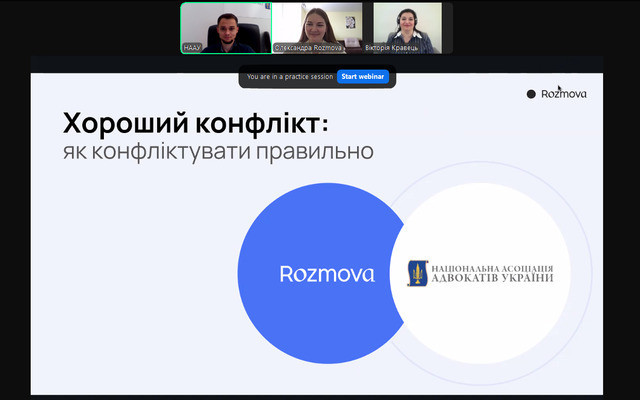
Advocates were taught how to resolve conflicts properly (video)

In these turbulent times—marked by armed conflicts, emotional burnout, and increasing pressure on professionals—conflicts have become a common feature of the professional environment. However, instead of causing destruction, they can serve as a tool for development, provided they are managed properly.
On June 6, the Ukrainian National Bar Association held a webinar entitled «Good Conflict: How to Conflict Correctly». The event, organized with the support of the International Bar Association (IBA), was part of a large-scale project to support the mental health of Ukrainian lawyers during the war.
Psychologist and Gestalt therapist Viktoria Kravets helped advocates find inner resources in conditions of stress and professional burnout.
«From a psychotherapeutic point of view, conflict is a clash of opposing interests, values, or desires, which is not necessarily destructive, - she noted. - A «good» conflict is a process that allows participants to maintain contact, better understand themselves and each other, and ultimately reach a constructive solution». According to the speaker, this approach is especially important for lawyers who find themselves in a conflict-prone environment every day, both in court and in interpersonal relationships.
The psychologist emphasized the main markers of «healthy» conflict: maintaining dialogue between the parties, a sincere desire to listen to each other, focusing on the problem rather than the personality, a willingness to pause during emotionally charged moments, and clarity of intentions. «After a good conflict, there is no residue — there is relief, understanding, and a willingness to change», - said V. Kravets.
The webinar participants paid special attention to the fear of conflict, which is often associated with negative past experiences, internal inhibitions against expressing aggression, or fear of destroying relationships. At the same time, avoiding conflict usually leads to the accumulation of hidden tension and the deepening of problems.
The webinar looked at the most common strategies for dealing with conflict: avoidance, compromise, competition, accommodation, cooperation, and mediation. The speaker talked about the strengths and weaknesses of each approach, encouraging participants not to avoid conflict but to learn how to choose effective tactics depending on the situation.
A separate section was devoted to practical tools for ecological conflict resolution using nonviolent communication (NVC) techniques, including:
- observation: stating facts without emotional judgments («When I see/hear...»);
- feelings: talking about your emotions rather than blaming («I feel...»);
- needs: being aware of your own needs behind your emotions («...because it is important to me...»);
- requests: formulating clear and realistic requests («Could you...?»).
In conclusion, participants discussed how this knowledge can be applied in the daily work of a lawyer — in particular in communication with clients, colleagues, opponents in court proceedings, and within the team. With the right approach, conflict can be not only a test but also a resource for growth.
The UNBA continues a series of events aimed at strengthening the emotional resilience of lawyers, developing self-regulation skills, and adapting to professional challenges in wartime. All interested advocates are welcome to join the next webinars, master classes, and psycho-emotional support programs within the joint project with the IBA.
© 2025 Unba.org.ua Всі права захищені
"Національна Асоціація Адвокатів України". Передрук та інше використання матеріалів, що розміщені на даному веб-сайті дозволяється за умови посилання на джерело. Інтернет-видання та засоби масової інформації можуть використовувати матеріали сайту, розміщувати відео з офіційного веб-сайту Національної Асоціації Адвокатів України на власних веб-сторінках, за умови гіперпосилання на офіційний веб-сайт Національної Асоціації Адвокатів України. Заборонено передрук та використання матеріалів, у яких міститься посилання на інші інтернет-видання та засоби масової інформації. Матеріали позначені міткою "Реклама", публікуються на правах реклами.